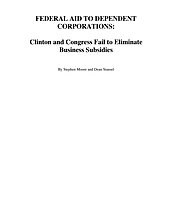We find that in 1995 Congress reduced corporate welfare spending by about 15 percent. In 1996, however, of the $37.7 billion budgeted for 55 of the least defensible programs, Congress increased spending by about $500 million. That was a 1.3 percent increase from the 1996 level.
Many corporate subsidy programs were reduced minimally or not at all by Congress. Those programs include the Agricultural Research Service, the International Trade Administration, the Payments to Air Carriers program, Federal Crop Insurance Corporation, the Commercial Space Transportation Office, the Overseas Private Investment Corporation, the Export-Import Bank, and the Agriculture Department’s Market Access Program, which subsidizes the foreign advertising of U.S. corporations such as Pillsbury, Dole, and Jim Beam.
The Clinton administration has also shown itself hostile to corporate welfare cutbacks. For the 55 corporate welfare programs examined in this study, the administration’s 1997 budget requested a 3.6 percent increase in spending. Moreover, the president’s vetoes of the GOP budgets specifically targeted corporate welfare cuts as being too deep. The White House has resisted even small cutbacks in such areas as high-technology industry grants, agriculture price supports, and energy research programs. It also has rejected the shutdown of the Department of Commerce–the nerve center of the corporate welfare state.

